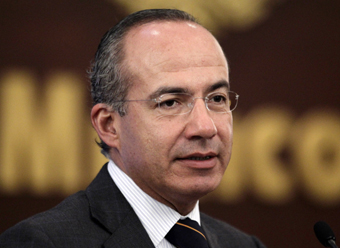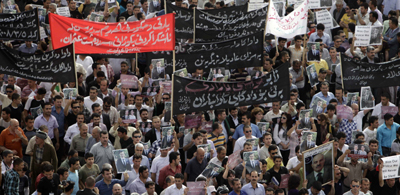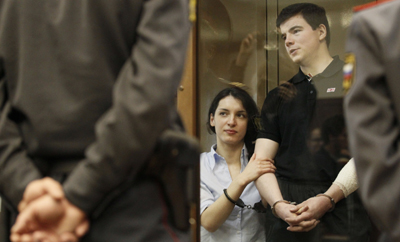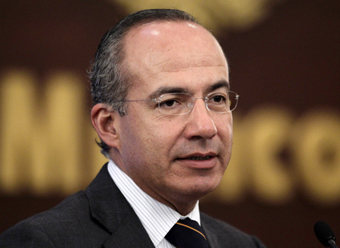CPJ’s 2011 Impunity Index spotlights countries
where journalists are slain and killers go free
Published June 1, 2011
NEW YORK
Russia and Mexico, two of the world’s most murderous countries for the press, are heading in different directions in combating deadly anti-press violence, the Committee to Protect Journalists has found in its newly updated Impunity Index. The index, which calculates unsolved journalist murders as a percentage of each country’s population, found improvement in Russia as journalist murders ebbed and prosecutors obtained two high-profile convictions. But deadly anti-press violence continued to climb in Mexico, where authorities appear powerless in bringing killers to justice.
About This Report
• The Index
• Methodology
• Statistical Table
More on This Issue
• Video Report:
Murdered With Impunity
• CPJ’s Campaign
Against Impunity
In Print
• Download the pdf
In Other Languages
• Español
• Русский
• Français
• العربية
• Português
Colombia continued a years-long pattern of improvement, CPJ’s index found, while conditions in Bangladesh reflected a slight upturn. But the countries at the top of the index—Iraq, Somalia, and the Philippines—showed either no improvement or even worsening records. Iraq, with an impunity rating three times worse than that of any other nation, is ranked first for the fourth straight year. Although crossfire and other conflict-related deaths have dropped in Iraq in recent years, the targeted killings of journalists spiked in 2010.
“The findings of the 2011 Impunity Index lay bare the stark choices that governments face: Either address the issue of violence against journalists head-on or see murders continue and self-censorship spread,” said CPJ Executive Director Joel Simon. “Convictions in Russia are a hopeful sign after years of indifference and denial. But Mexico’s situation is deeply troubling, with violence spiking as the government promises action but fails to deliver.”
CPJ’s annual Impunity Index, first published in 2008, identifies countries where journalists are murdered regularly and governments fail to solve the crimes. For this latest index, CPJ examined journalist murders that occurred between January 1, 2001 through December 31, 2010, and that remain unsolved. Only the 13 nations with five or more unsolved cases are included on the index. Cases are considered unsolved when no convictions have been obtained.
Impunity is a key indicator in assessing levels of press freedom and free expression in nations worldwide. CPJ research shows that deadly, unpunished violence against journalists often leads to vast self-censorship in the rest of the press corps. From Somalia to Mexico, CPJ has found that journalists avoid sensitive topics, leave the profession, or flee their homeland to escape violent retribution.

In the past year, CPJ delegations have met with heads of state in the Philippines, Mexico, and Pakistan, and with senior law enforcement officials in Russia, to seek systemic reforms and convictions in unsolved cases. In each instance, top officials pledged to reverse the record of impunity in their countries, but the task is considerable. CPJ research shows that, time and again, entrenched corruption and dysfunction in law enforcement has thwarted justice in journalist murders. Suspects have been publicly identified in dozens of unsolved cases examined by CPJ for this index, but authorities have been unable or unwilling to gain convictions.
In Mexico, President Felipe Calderón Hinojosa’s administration has adopted some broad reforms—strengthening the office of the special prosecutor for crimes against free expression, for one—but prosecutors are still failing to win convictions in a corruption-plagued legal system. In the Philippines, President Benigno Aquino has pledged to successfully prosecute those responsible for the 2009 massacre of dozens of journalists and others in Maguindanao province. But trial proceedings thus far have been marred by threats and bribes targeting witnesses.
Among the 13 nations on the 2011 index, Russia has made measurable progress, CPJ research shows. Senior investigative officials reopened several unsolved journalist murder cases after meeting with a CPJ delegation in 2010, and, in April, prosecutors won convictions in the 2009 murder of reporter Anastasiya Baburova in Moscow.

“In order to reduce their ranking on the Impunity Index governments must do two things: Solve crimes and prevent further violence. One strategy for achieving this is to ensure that law enforcement responds aggressively when journalists are threatened,” said CPJ’s Simon. “Such threats need to be thoroughly investigated and, when appropriate, threatened journalists should be provided with security and assistance in temporary relocation. The Colombian government has made a significant commitment to journalist protection, and that commitment shows in its improved rating on the index.”
Among other findings in the Impunity Index:
- Brazil returns to the index after dropping off a year ago. While Brazilian authorities have had success in prosecuting journalist murders, winning several convictions in recent years, the country still sees persistent anti-press violence. The October 2010 murder of a muckraking radio reporter became the country’s fifth unsolved case in the past decade.
- Local journalists are the victims in the vast majority of unsolved cases worldwide. Only about 6 percent of unsolved cases on the index involve international journalists slain while working abroad.
- Prior threats against a journalist are powerful indicators of violence to come. More than 40 percent of the victims in this index had received threats prior to being killed.
- In countries with weak law enforcement, political reporting is the most dangerous beat. Among the unsolved cases on this index, nearly 30 percent of victims had covered politics.
- About 28 percent of victims covered armed conflict, reflecting a long-term phenomenon documented by CPJ. Even in war zones, CPJ has found, the targeted killing of journalists is common.
- As reflected in past editions of the index, impunity is severe across South Asia. Six of the region’s nations—Sri Lanka, Afghanistan, Nepal, Pakistan, Bangladesh, and India—are on the 2011 index.
CPJ is releasing its 2011 Impunity Index at the 17th general meeting of the International Freedom of Expression Exchange in Beirut, which brings together press freedom advocates from around the world. CPJ’s Impunity Index is compiled as part of the organization’s Global Campaign Against Impunity. Underwritten by the John S. and James L. Knight Foundation, the campaign has focused on two of the world’s worst offenders, Russia and the Philippines.
For a detailed explanation of CPJ’s methodology, click here.
The Index
Here are the 13 countries where journalists are murdered on a recurring basis and governments are unable or unwilling to prosecute the killers. The index covers the years 2001 through 2010.
1 IRAQ

The scourge of impunity worsened in Iraq, a country with a rating far worse than anywhere else in the world. None of the 92 journalist murders recorded in Iraq in the past decade has been solved, and, after a brief decline in targeted killings, journalist murders spiked in 2010. Among the four murder victims in 2010 was Sardasht Osman, a contributor to several news outlets who had received numerous threats for coverage that accused Kurdistan Regional Government officials of corruption. The investigation of his murder is emblematic of the deeply entrenched culture of impunity in Iraq. Authorities took no discernible action in the case until they faced intense international pressure. Then, investigators produced a cursory, 430-word report that vaguely accused Osman of having links to an extremist group that led to his killing. The report, which cited no supporting evidence for its claims, was widely denounced for lacking credibility and transparency.
Impunity Index Rating: 2.921 unsolved journalist murders per 1 million inhabitants.
Last year: Ranked 1st with a rating of 2.794.
2 SOMALIA
With 10 unsolved murders in the last decade, Somalia has the worst rating in Africa and holds the second spot worldwide. The victims include Sheikh Nur Mohamed Abkey, who was tortured and shot multiple times in May 2010. Al-Shabaab militants claimed responsibility for the murder of Abkey, one of the country’s most senior journalists, in reprisal for his work at state-run Radio Mogadishu. Somalia’s impunity rating is one element in a devastated media landscape: Nearly 60 Somali journalists have fled the country in the past decade in the face of threats, CPJ research shows, and those remaining practice extreme self-censorship to survive.
Impunity Index Rating: 1.099 unsolved journalist murders per 1 million inhabitants.
Last year: Ranked 2nd with a rating of 1.000.
3 PHILIPPINES

Top justice officials met at length with CPJ in 2010 to discuss the problem of impunity, with President Aquino offering his personal pledge to reverse the nation’s record of unpunished, anti-press violence. But Philippine officials also stressed the difficulty of the task in a country where 56 journalists have been killed with impunity over the past decade. The government’s case against dozens of defendants in the 2009 massacre in Maguindanao province, in which 32 journalists and media workers were killed, reflects an overall pattern in which Philippine authorities often identify suspects but rarely win convictions. Initial trial proceedings in the Maguindanao killings have been plagued by threats and bribes targeting witnesses, and incompetence and corruption among local investigators. The slow-moving prosecution has yielded no convictions thus far. In the meantime, deadly violence continues: Radio journalists Joselito Agustin and Desidario Camangyan were murdered in 2010 after reporting on local corruption.
Impunity Index Rating: 0.609 unsolved journalist murders per 1 million inhabitants.
Last year: Ranked 3rd with a rating of 0.609.
4 SRI LANKA
President Mahinda Rajapaksa has presided over a dark era of targeted media killings and complete law enforcement failure in addressing the crimes. All nine journalist murders in the past decade have gone unsolved, leaving persistent questions as to whether authorities have been complicit in some of the crimes. Illustrating the problems is the 2009 murder of Lasantha Wickramatunga, who, as one of the country’s leading editors, was a prominent critic of government policies. Wickramatunga was beaten to death by a group of motorcycle-riding assailants along a busy, suburban Colombo street on a weekday morning. The government staged investigative hearings without making any progress in apprehending suspects. As Wickramatunga’s wife, Sonali Samarasinghe, wrote on the CPJ Blog: “The government has stonewalled the investigation while passing it around like a hot potato from one investigating body to another.”
Impunity Index Rating: 0.443 unsolved journalist murders per 1 million inhabitants.
Last year: Ranked 4th with a rating of 0.496.
5 COLOMBIA
Historically one of the most murderous places in the world for journalists, Colombia has earned its very poor ranking on the index. But the country showed its fourth consecutive year of improvement as deadly anti-press violence has slowed and authorities have had some success in prosecuting journalist murders. Much work remains: Eleven journalist murders over the past decade remain unsolved. Among them is the March 2010 killing of Montería newspaper editor Clodomiro Castilla Ospino, who was fatally shot after covering links between illegal right-wing paramilitary groups and local politicians. Colombian journalists, particularly in provincial areas, say they still work under extreme duress and often practice self-censorship.
Impunity Index Rating: 0.241 unsolved journalist murders per 1 million inhabitants.
Last year: Ranked 5th with a rating of 0.292.
6 AFGHANISTAN

Afghanistan is in a holding pattern with no new murders reported but no convictions won in any of seven unsolved cases over the past decade. The unsolved cases include the 2008 murder of Abdul Samad Rohani, a reporter for the BBC’s Pashto service and contributor to the local Pajhwok Afghan News agency. Rohani was shot multiple times near Lashkar Gah, capital of Helmand province, after reporting on alleged links between drug traffickers and government officials.
Impunity Index Rating: 0.235 unsolved journalist murders per 1 million inhabitants.
Last year: Ranked 6th with a rating of 0.240.
7 NEPAL
Six local reporters and editors have been murdered with complete impunity in the past decade. Maoist cadres are suspected in a number of the killings, including the 2007 murder of reporter Birendra Shah, whose coverage had been critical of what was then an armed Maoist insurgency. After joining the government in 2008, Maoist leaders pledged to investigate the numerous press freedom violations that had been ascribed to their members, including several non-fatal attacks and abductions. Yet no evident progress has been made in achieving justice.
Impunity Index Rating: 0.205 unsolved journalist murders per 1 million inhabitants.
Last year: Ranked 7th with a rating of 0.210.
8 MEXICO
Mexico’s impunity rating worsened for the third consecutive year. At least 13 journalist murders have gone unsolved in the past decade amid widespread corruption in local government and law enforcement. In 2010, gunmen killed Luis Carlos Santiago, a photographer for the Ciudad Juarez newspaper El Diario, in a shopping center parking lot on a weekday afternoon. The killing came just two years after El Diario’s crime reporter, Armando Rodríguez Carreón, was gunned down in front of his young daughter. The murders prompted the paper to drastically curtail coverage of drug trafficking and crime, illustrating the devastating effects of unpunished, anti-press violence in Mexico. CPJ documented impunity in Mexico in a 2010 special report, Silence or Death in Mexico’s Press, and a delegation elicited promises of reform from President Calderón. But while a special prosecutor’s office has been strengthened, other proposed reforms—including the federalization of crimes against the press—are moving slowly.
Impunity Index Rating: 0.121 unsolved journalist murders per 1 million inhabitants.
Last year: Ranked 9th with a rating of 0.085.
9 RUSSIA

No journalists were murdered in reprisal for their work in 2010, the first year since 1999 that no targeted media killings were reported in Russia. At the same time, authorities won convictions in the 2009 double-murder of reporter Anastasiya Baburova and human rights lawyer Stanislav Markelov. But those murders, committed on a downtown Moscow street by two radical nationalists, may prove much easier to close than the 16 unsolved cases over the past decade. They include the contract killings of investigative journalists Anna Politkovskaya and Paul Klebnikov; the abduction and murder of Natalya Estemirova, who covered human rights in the volatile North Caucasus, and the mysterious poisoning of the critical newspaper editor Yuri Shchekochikhin. In meetings with a CPJ delegation in September 2010, high-ranking law enforcement officials pledged to re-examine five cold journalist murder cases, and they reported progress in the Politkovskaya slaying and other cases.
Impunity Index Rating: 0.113 unsolved journalist murders per 1 million inhabitants.
Last year: Ranked 8th with a rating of 0.127.
10 PAKISTAN
At least 14 journalist murders have gone unsolved between 2001 and 2010. The victims include Misri Khan, a veteran reporter and local journalist association leader, who was shot multiple times in September 2010 as he entered the press club building in Hangu, a volatile town near the Afghan border. Colleagues said he had received numerous threats from militant groups. In May 2011, President Asif Ali Zardari met with a CPJ delegation and pledged to renew investigations into the unsolved cases and to take a more assertive stance in combating anti-press violence overall.
Impunity Index Rating: 0.082 unsolved journalist murders per 1 million inhabitants.
Last year: Ranked 10th with a rating of 0.072.
11 BANGLADESH
Bangladesh’s impunity rating improved slightly, reflecting the fifth consecutive year without a journalist murdered. But authorities have produced no results in solving the five journalist murders that occurred in the first half of the decade. All of the victims were print reporters covering local stories of corruption and crime. Among them was Nahar Ali, a correspondent for the Bengali-language daily Anirban, who died in April 2001 from injuries sustained days earlier when masked men kidnapped, stabbed, and beat him. Local journalists said Ali’s murder was linked to his reporting on police corruption and local criminal syndicates. To this day, authorities have made no arrests.
Impunity Index Rating: 0.031 unsolved journalist murders per 1 million inhabitants.
Last year: Ranked 11th with a rating of 0.044.
12 BRAZIL
Brazil has been on and off CPJ’s Impunity Index over the past four years, illustrating its mixed record in combating journalist murders. Although authorities have successfully prosecuted a number of journalist murders, the country continues to see persistent anti-press violence. Brazil returns to the index this year because of the October 2010 murder of radio reporter Francisco Gomes de Medeiros. The Gomes case became the fifth unsolved murder in the past decade in Brazil. But authorities appear to be making progress in the case, apprehending the alleged gunman and mastermind, and raising hopes that the case may be solved.
Impunity Index Rating: 0.026 unsolved journalist murders per 1 million inhabitants.
Not listed on the 2010 Impunity Index because it had fewer than five unsolved murders.
13 INDIA
With seven unsolved media murders and no apparent political will to prosecute the cases, India retained its spot on CPJ’s index. The victims include reporter Prahlad Goala, who was murdered in 2006 in the northeastern state of Assam after writing a series of articles on corruption in the local forestry service. Police arrested a forestry official shortly after the murder but soon released him; other suspects were later taken into custody, but no convictions have been obtained.
Impunity Index Rating: 0.006 unsolved journalist murders per 1 million inhabitants.
Last year: Ranked 12th with a rating of 0.006.
Methodology
CPJ’s Impunity Index calculates the number of unsolved journalist murders as a percentage of each country’s population. For this index, CPJ examined journalist murders that occurred between January 1, 2001 through December 31, 2010, and that remain unsolved. Only those nations with five or more unsolved cases are included on this index.
CPJ defines murder as a deliberate attack against a specific journalist in relation to the victim’s work. Murders make up more than 70 percent of work-related deaths among journalists, according to CPJ research. This index does not include cases of journalists killed in combat or while carrying out dangerous assignments such as coverage of street protests.
Cases are considered unsolved when no convictions have been obtained. Population data from the World Bank’s 2009 World Development Indicators were used in calculating each country’s rating.
CPJ consulted Mary Gray, professor of mathematics and statistics at American University in Washington, when it initially developed its methodology in 2008. Gray has served on the boards and committees of groups such as Amnesty International. In 2001, Gray received the Presidential Award for Excellence in Science, Mathematics, and Engineering Mentoring.
CPJ’s Impunity Index looks specifically at unsolved journalist murders. On an ongoing basis, CPJ maintains a comprehensive database of all journalists killed in the line of duty and narrative capsules that detail the circumstances of each case. Our interactive map breaks down trends by country and year.
CPJ welcomes comments about this index.
Statistical Table
Unsolved journalist murders per 1 million inhabitants for 2001-2010. Only nations with five or more unsolved cases are included. Cases are considered unsolved when no convictions have been obtained.
| Rank | Nation | Unsolved Cases | Population (in millions) |
Calculation | Rating |
| 1 | Iraq | 92 | 31.5 | 92/31.5 | 2.921 |
| 2 | Somalia | 10 | 9.1 | 10/9.1 | 1.099 |
| 3 | Philippines | 56 | 92 | 56/92 | 0.609 |
| 4 | Sri Lanka | 9 | 20.3 | 9/20.3 | 0.443 |
| 5 | Colombia | 11 | 45.7 | 11/45.7 | 0.241 |
| 6 | Afghanistan | 7 | 29.8 | 7/29.8 | 0.235 |
| 7 | Nepal | 6 | 29.3 | 6/29.3 | 0.205 |
| 8 | Mexico | 13 | 107.4 | 13/107.4 | 0.121 |
| 9 | Russia | 16 | 141.8 | 16/141.8 | 0.113 |
| 10 | Pakistan | 14 | 169.7 | 14/169.7 | 0.082 |
| 11 | Bangladesh | 5 | 162.2 | 5/162.2 | 0.031 |
| 12 | Brazil | 5 | 193.7 | 5/193.7 | 0.026 |
| 13 | India | 7 | 1,155.3 | 7/1,155.3 | 0.006 |
Population data source:
2009 World Development Indicators, World Bank
Country links:
Click on country links to view CPJ’s comprehensive database of journalists murdered. The database covers the years 1992-2011.
